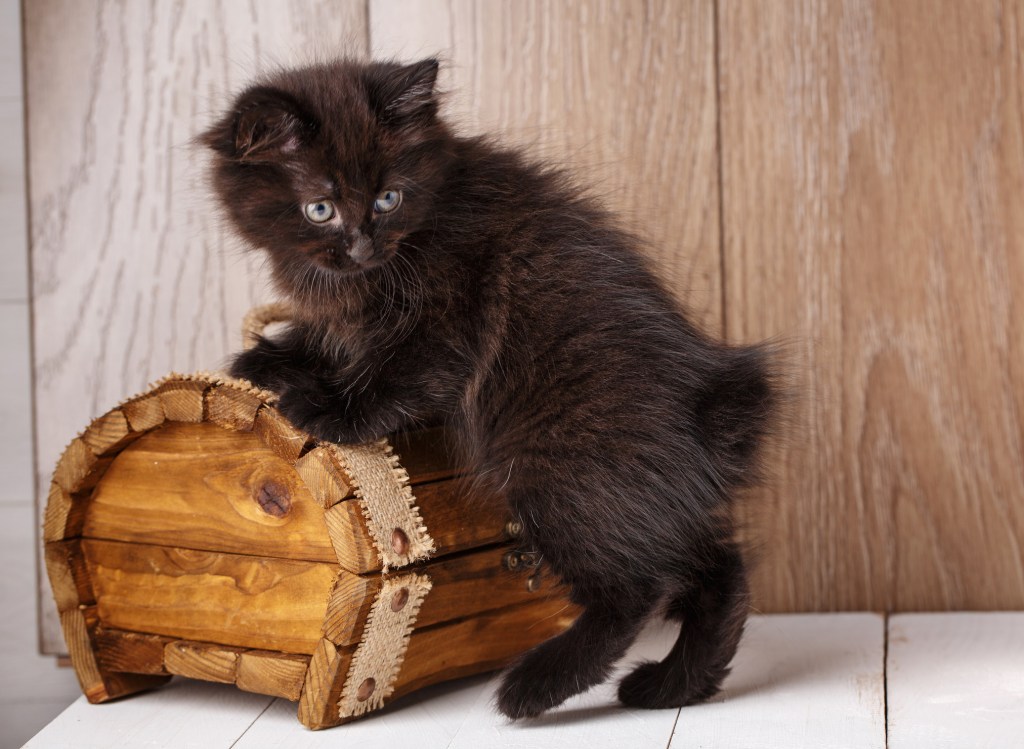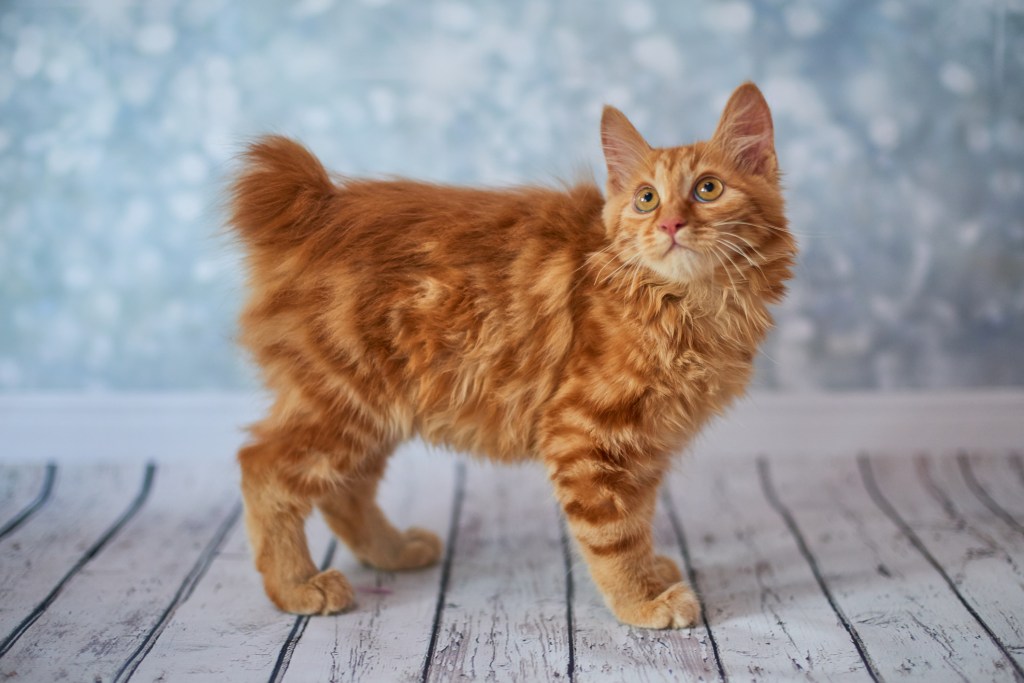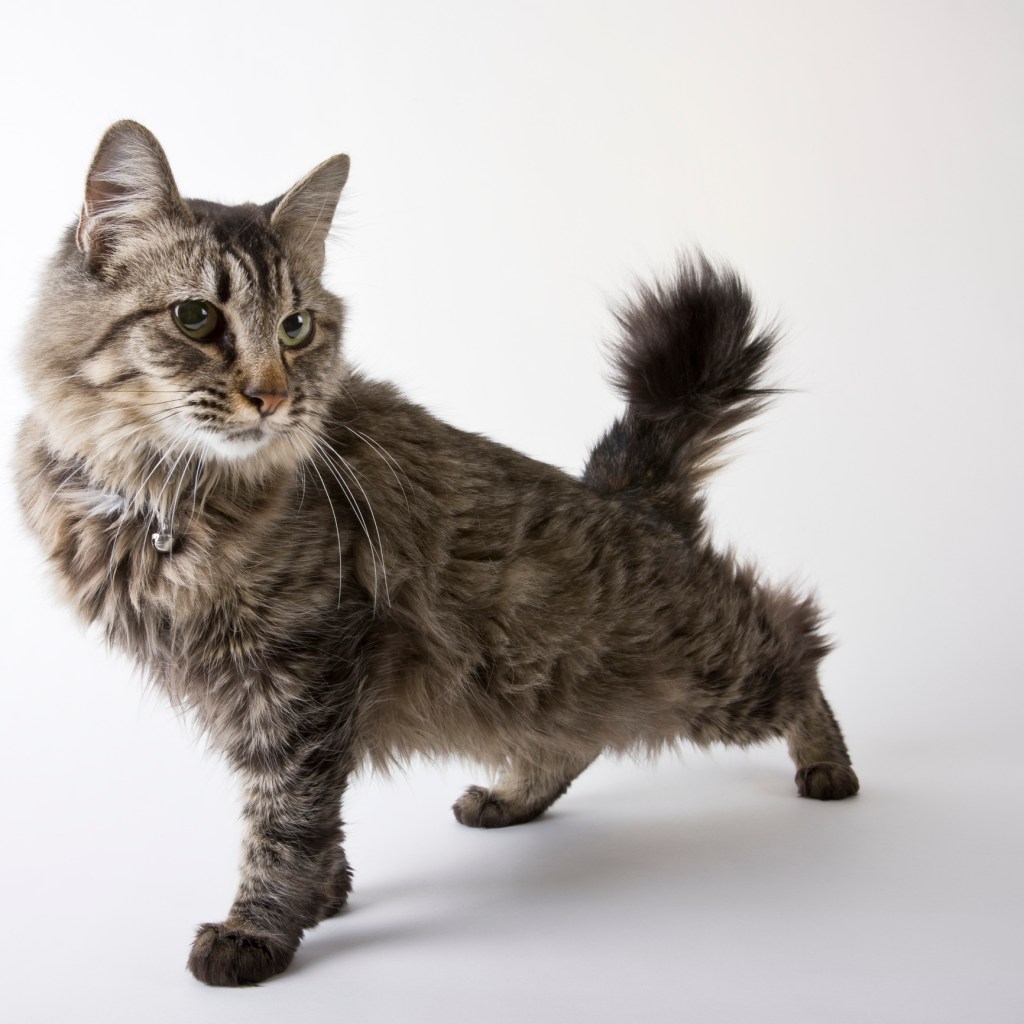The American Bobtail is a distinctive and eye-catching cat breed known for their unique short tail, wild appearance, and friendly demeanor. With a well-muscled and athletic body, these cats exhibit a wild charm reminiscent of their supposed bobcat ancestry. The most prominent feature is their short, bobbed tail, which can vary in length and may have a kink, curve, or be straight. The breed’s coat comes in various colors and patterns, with a semi-long to short length, providing them with a luxurious and soft texture. American Bobtails have expressive almond-shaped eyes that can be of different colors, contributing to their captivating and engaging gaze.
In terms of temperament, American Bobtails are renowned for their intelligence, playfulness, and adaptability. These cats are known to form strong bonds with their human companions, displaying a gentle and affectionate nature. They are often good with children and other pets, making them an excellent choice for families. Despite their wild appearance, American Bobtails are generally easygoing, making them well-suited to various living environments. Their love for interactive play and their ability to learn tricks contribute to the overall charm of this breed, making them cherished and delightful companions for those seeking engaging feline friends.
When considering an American Bobtail kitten, it’s advisable to prioritize adopting from rescue organizations or shelters to provide a loving home to a cat in need. However, if you decide to purchase, it’s crucial to choose a reputable breeder. Conduct thorough research to ensure that the breeder follows ethical practices and prioritizes the well-being of their cats. Reputable American Bobtail kitten breeders prioritize the health and temperament of their cats, conduct necessary health screenings, and provide a nurturing environment for the kitties. This active approach ensures that you bring home a healthy and happy kitty while discouraging unethical breeding practices.
Quick Facts
- Origin: United States, 1960s, developed by breeding a feral bobtail cat with domestic shorthairs, preserving the bobtail trait.
- Size: Medium (7-16 pounds), with males generally larger than females.
- Breed Group: Landrace (naturally occurring breed)
- Lifespan: 13-15 years
- Coat: Short or longhaired, comes in a vast array of colors and patterns including solid, tabby, bi-color, tortoiseshell, and pointed.
- Temperament: Playful, friendly, adaptable, intelligent, affectionate, enjoys human interaction and playtime.
- Exercise Needs: Moderate – appreciates daily playtime and mental stimulation but content with quiet time too.
- Training: Trainable with positive reinforcement due to their intelligence, can learn tricks and even leash training.
- Grooming: Weekly brushing for short-haired, more frequent for longhaired, to prevent matting.
- Health: Generally healthy, but some potential for genetic health conditions.
- The short tail is a result of a genetic mutation.
- Some American Bobtail cats are used as therapy cats.
- Their short tails can wag to express a good mood.
American Bobtail Pictures




-
Affectionate with Family
Some cat breeds are typically independent and aloof, even if they’ve been raised by the same person since kittenhood; others bond closely to one person and are indifferent to everyone else; and some shower the whole family with affection. Breed isn’t the only factor that goes into affection levels; cats who were raised inside a home with people around feel more comfortable with humans and bond more easily.

See Cats Less Affectionate with Family -
Amount of Shedding
If you’re going to share your home with a cat, you’ll need to deal with some level of cat hair on your clothes and in your house. However, shedding does vary among the breeds. If you’re a neatnik, you’ll need to either pick a low-shedding breed or relax your standards. This furniture cover can make it easier to clean up cat hair and keep it off your sofa!
-
General Health
Due to poor breeding practices, some breeds are prone to certain genetic health problems. This doesn’t mean that every cat of that breed will develop those diseases; it just means that they’re at an increased risk. If you’re looking only for purebred cats or kittens, it’s a good idea to find out which genetic illnesses are common to the breed you’re interested in.
-
Potential for Playfulness
Some cats are perpetual kittens—full of energy and mischief—while others are more serious and sedate. Although a playful kitten sounds endearing, consider how many games of chase the mouse-toy you want to play each day, and whether you have kids or other animals who can stand in as playmates. A classic wand cat toy like this one is perfect for playful felines!
-
Tendency to Vocalize
Some breeds sound off more often than others with meows, yowls, and chattering. When choosing a breed, think about how the cat vocalizes and how often. If constant “conversation” drives you crazy, consider a kitty less likely to chat.
-
Kid-Friendly
Being tolerant of children, sturdy enough to handle the heavy-handed pets and hugs they can dish out, and having a nonchalant attitude toward running, screaming youngsters are all traits that make a kid-friendly cat. Our ratings are generalizations, and they’re not a guarantee of how any breed or individual cat will behave; cats from any breed can be good with children based on their past experiences and personality.
-
Friendly Toward Strangers
Stranger-friendly cats will greet guests with a curious glance or a playful approach; others are shy or indifferent, perhaps even hiding under furniture or skedaddling to another room. However, no matter what the breed, a cat who was exposed to lots of different types, ages, sizes, and shapes of people as a kitten will respond better to strangers as an adult.
-
Easy to Groom
Some breeds require very little in the way of grooming; others require regular brushing to stay clean and healthy. Consider whether you have the time and patience for a cat who needs daily brushing. You should definitely pick up this awesome de-shedding tool for cats of any hair length!
-
Intelligence
Some cat breeds are reputed to be smarter than others. But all cats, if deprived the mental stimulation they need, will make their own busy work. Interactive cat toys are a good way to give a cat a brain workout and keep them out of mischief. This scratcher cat toy can keep your smart kitty busy even when you’re not home!
-
Pet Friendly
Friendliness toward other household animals and friendliness toward humans are two completely different things. Some cats are more likely than others to be accepting of other pets in the home.
American Bobtail History
Bobtailed cats, the result of a natural genetic mutation that causes a shortened tail, have appeared in various places over the centuries, from Japan to the Isle of Man. Sometimes they get noticed by the right people, and voila! A new breed is born.
Such was the case with the American Bobtail, which descends from a short-tailed kitten acquired by John and Brenda Sanders during a vacation to Arizona. They named him Yodi, and he became the father of the breed in the swinging ‘60s when he had his way with the Sanders’ female, Mishi, once they arrived back home in Iowa. Yodi and Mishi’s kittens had short tails, too, a clue that the trait was caused by a dominant gene.
Family friend Mindy Shoultz, who’d had experience breeding Persians, partnered with Charlotte Bentley to develop the unusual cats into a breed. They bred the kittens to other cats with naturally short tails that were found in various places throughout the United States and Canada. They selectively bred the cats to be big and sturdy with a wild look but a sweet temper. All of the cats used to develop the breed were non-pedigreed domestic shorthairs and longhairs.
Now, after 50 years, such outcrossing is no longer necessary because now the cats have pedigrees longer than their tails. The International Cat Association accepted the American Bobtail into its new breed category in 1989 and gave it full recognition in 2002. The American Bobtail is also recognized by the Cat Fanciers Association and the American Cat Fanciers Association.
American Bobtail Size
The American Bobtail typically weighs 8 to 13 pounds.
American Bobtail Personality
Let’s say you love the Golden Retriever’s personality, but his size and energy level are a bit more than you can handle. American Bobtail lovers say you should take a look at their cat instead. He’s a lover with a heart of gold who is devoted to his people, follows them around, loves to play, walks nicely on a leash (after training, of course), and welcomes guests with a smile.
This is a smart cat who enjoys puzzle toys, learning tricks, and playing fetch. He isn’t as vocal as some breeds, but he communicates his pleasure with chirps, clicks and trills, as well as the standard purr and meow. The American Bobtail has an adaptable nature, so he’s a good traveler. Long-distance truckers and RVers find him to be an excellent companion.
The cats have also found a niche with some psychotherapists because of their loving and intuitive nature. That same adaptability and kindness makes him a good family companion and suited to a variety of lifestyles, from relaxed to rowdy.
American Bobtail Health
Both pedigreed cats and mixed-breed cats have varying incidences of health problems that may be genetic in nature. American Bobtails are generally healthy, but always keep an eye out for signs that your cat might be in distress or pain.
American Bobtail Care
The American Bobtail’s coat doesn’t usually mat or tangle as long as you comb or brush it a couple of times a week. You may notice that the cat sheds more in the spring and fall, so it can be a good idea to groom him more frequently during those times. A bath is rarely necessary.
Brush the teeth to prevent periodontal disease. Daily dental hygiene is best, but weekly brushing is better than nothing. Trim the nails every couple of weeks. Wipe the corners of the eyes with a soft, damp cloth to remove any discharge. Use a separate area of the cloth for each eye so you don’t run the risk of spreading any infection.
Check the ears weekly. If they look dirty, wipe them out with a cotton ball or soft damp cloth moistened with a 50-50 mixture of cider vinegar and warm water. Avoid using cotton swabs, which can damage the interior of the ear. Keep the litter box spotlessly clean. Cats are very particular about bathroom hygiene.
It’s a good idea to keep an American Bobtail as an indoor-only cat to protect him from diseases spread by other cats, attacks by dogs or coyotes, and the other dangers that face cats who go outdoors, such as being hit by a car. American Bobtails who go outdoors also run the risk of being stolen by someone who would like to have such a beautiful cat without paying for it.
American Bobtail Coat Color And Grooming
With his short tail, tufted ears and toes, and powerful body, the American Bobtail has a distinctively wild look—similar to that of a bobcat—but he’s a domestic cat through and through. He ranges in size from medium to large and matures slowly, taking up to three years to reach his full size.
Since this breed is distinguished by his short tail, it’s as good a place as any to begin a description of his looks. Each tail is unique. Most are 1 to 4 inches long, but they can be shorter or longer. The ideal bobtail is flexible and expressive, long enough to be visible above the back when the cat is alert, and may be straight with a fat pad at the end, slightly curved or kinked, or bumpy along the length of the tail.
Kittens are almost never completely tailless, as sometimes happens with the Manx. Some litters have kittens with full-length tails. They won’t be stars in the show ring, but they can be used in breeding programs. The noticeably athletic body is covered with shaggy fur in two lengths. The shorthaired American Bobtail actually has a medium-length double coat with hard outer hairs overlaying a soft, downy undercoat.
When the coat is a dilute color, a lynx point or a silver, the coat may have a softer texture. Longhaired Bobtails have a ruff around the neck and long hair on the britches (upper hind legs), belly and tail. On the face, the longhair may look as if he is sporting mutton chops. The fur comes in all colors and patterns. The eyes can be any color except odd (each eye a different color).
Children And Other Pets
The social and laidback American Bobtail likes to play, so he’s a good choice for families with children. Always supervise younger children to make sure they don’t hurt the cat by pulling his fur or twisting his tail.
He is happy to live with other cats and cat-friendly dogs, too, thanks to his amiable disposition. Introduce pets slowly and in controlled circumstances to ensure that they learn to get along together.
American Bobtail Rescue Groups
More Info For You
If you’re also looking for a dog, check out DogTime’s dog breed page!





